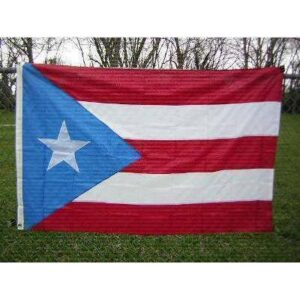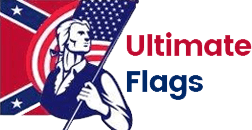Home » Puerto Rico Flag
Product Categories

Puerto Rico Flag
Puerto Rican Flag: A Symbol of Pride and Heritage
Introduction to the Puerto Rico Flag
Puerto Rico, a vibrant gem in the Caribbean, stands out not just for its rich culture and history, but also for its unique national symbol: the Puerto Rican flag. This banner, a symbol of pride for Puerto Ricans both on the island and around the world, tells a story of resilience, identity, and heritage.
History of the Puerto Rican Flag
The Puerto Rican flag’s journey is as colorful as its design. Originally inspired by the Cuban flag, it was first flown in 1895 as a symbol of the island’s quest for independence from Spanish rule. This early version was conceived by a group of Puerto Ricans in New York City, indicating the deep-rooted connection of the diaspora to their homeland.
Did You Know? The original Puerto Rican flag was sewn by Mariana Bracetti, a key figure in the independence movement.
Puerto Rico Flag Design and Symbolism
At the heart of the Puerto Rican flag’s design lies a rich tapestry of symbolism. The three red stripes represent the blood that nourishes the three branches of government, while the two white stripes symbolize individual liberty and the rights that safeguard it. The blue triangle stands for the Commonwealth of Puerto Rico, and the lone star represents the island’s independent state.
Question: What does the star in the Puerto Rican flag symbolize?
Answer: The star symbolizes the Commonwealth of Puerto Rico and its identity as a distinct political entity.
Puerto Rican Pride and the Flag
For Puerto Ricans, their flag is more than a banner; it’s a declaration of cultural identity and pride. Whether it’s flown in Old San Juan or displayed in a Puerto Rican household in the United States, the flag is a unifying symbol, embodying the spirit and resilience of its people.
Quality of the Puerto Rico Flag Matters
When it comes to showcasing Puerto Rican pride, the quality of your PR flag matters. UltimateFlags.com offers high-quality Puerto Rico flags, sewn heavy duty outdoor flags, made in the USA, ensuring durability and authenticity. Their flags, crafted from superior materials like nylon and polyester, are not only symbols of national pride but also of American craftsmanship and family-operated business values.
Fact: UltimateFlags.com’s embroidered Puerto Rican flags are made using high-grade nylon, ensuring they withstand various weather conditions so you can display your Puerto Rico flag respectfully and take pride in your heritage whether in Puerto Rico or in the USA.
Puerto Rico Flag Facts / Questions
1. Why are the colors of the Puerto Rican flag significant?
The colors of the flag – red, white, and blue – symbolize bravery, purity, and justice, respectively, mirroring the values held dear by Puerto Ricans.
2. How does buying a flag from UltimateFlags.com support American businesses?
UltimateFlags.com is an American-owned and family-operated business. Purchasing from them means supporting the local economy and American entrepreneurship.
Puerto Rican Flags: The Enduring Spirit of the People
The flag of Puerto Rico is more than a piece of fabric; it’s a symbol of a nation’s soul, a tapestry of its history, and a beacon of its enduring spirit. By choosing a Puerto Rican flag from UltimateFlags.com, you’re not just owning a piece of heritage but also supporting American business values.
1. When was the Puerto Rican flag officially adopted?
The Puerto Rican flag was officially adopted on July 24, 1952, after Puerto Rico became a Commonwealth of the United States.
2. What inspired the design of the Puerto Rican flag?
The design of the Puerto Rican flag was inspired by the Cuban flag as a sign of solidarity and shared quest for independence from Spain.
3. Who designed the original Puerto Rican flag?
The original Puerto Rican flag was designed by Francisco Gonzalo Marin, a Puerto Rican revolutionary, in 1895.
4. What do the red stripes on the flag represent?
The red stripes on the Puerto Rican flag symbolize the blood shed by warriors in the quest for freedom and independence.
5. What is the significance of the white stripes?
The white stripes represent individual liberty and the rights that protect it, emphasizing the value of freedom.
6. What does the blue triangle in the flag symbolize?
The blue triangle symbolizes the three branches of government and represents the island's Republican form of government.
7. How many points does the star on the flag have?
The star on the Puerto Rican flag has five points, each representing a different administrative district of Puerto Rico.
8. Is the shade of blue in the flag always the same?
No, the shade of blue in the Puerto Rican flag has varied over time. Initially, it was a light sky blue, but it has also been a darker shade, similar to the U.S. flag.
9. Has the flag's design ever been altered?
Yes, the flag's design was slightly altered in 1952 when the shade of blue was changed to match that of the United States flag.
10. What does the lone star on the flag represent?
The lone star on the Puerto Rican flag represents the Commonwealth of Puerto Rico and its identity as a distinct political entity.
11. Is the Puerto Rican flag ever flown alongside other flags?
Yes, the Puerto Rican flag is often flown alongside the U.S. flag and other flags, especially in official and international settings.
12. How is the flag used in cultural celebrations?
The Puerto Rican flag is prominently displayed during cultural celebrations, parades, and festivals to symbolize national pride and heritage.
13. Can the flag be displayed in different orientations?
Yes, the Puerto Rican flag can be displayed vertically or horizontally, but the triangle should always be at the hoist side and the star should be upright.
14. Are there any laws governing the use of the flag?
Yes, there are laws and regulations governing the display and use of the Puerto Rican flag, similar to flag etiquette in the United States.
15. What does the Puerto Rican flag represent for the diaspora?
For the Puerto Rican diaspora, the flag represents a connection to their homeland, heritage, and cultural identity.
16. Is the flag used in political movements?
Yes, the Puerto Rican flag is often used in political movements and protests as a symbol of resistance and national identity.
17. How is the flag celebrated on Flag Day?
On Puerto Rican Flag Day, celebrated on December 22, the flag is honored with ceremonies, educational events, and public displays of pride.
18. What role did the flag play in the quest for independence?
The flag played a significant role in the quest for independence, serving as a symbol of rebellion and unity against colonial rule.
19. Are there any special protocols for flying the flag at half-mast?
Yes, the Puerto Rican flag is flown at half-mast during periods of national mourning, following similar protocols as the U.S. flag.
20. What is the difference between the civil and governmental flag?
The civil flag is used by citizens and has the light blue triangle, while the governmental flag used by official agencies has a darker blue triangle.
21. How is the flag integrated into Puerto Rican fashion?
The Puerto Rican flag is a popular motif in fashion, often used in clothing, accessories, and artwork to express cultural pride.
22. What does the flag mean for Puerto Rican athletes?
For Puerto Rican athletes, the flag is a symbol of national pride and unity, often displayed during international sporting events.
23. Has the flag ever been used in art?
Yes, the Puerto Rican flag is a common theme in art, symbolizing the island's culture, history, and struggles for independence.
24. How do schools in Puerto Rico teach about the flag?
Schools in Puerto Rico teach about the flag's history, symbolism, and etiquette as part of the curriculum on national heritage.
25. What is the significance of the flag during national holidays?
During national holidays, the Puerto Rican flag is a central symbol, representing unity, history, and national pride among Puerto Ricans.
26. Who was the first to raise the Puerto Rican flag?
The first person to officially raise the Puerto Rican flag was Manuel Besosa, during the Grito de Lares, Puerto Rico's initial rebellion against Spanish rule in 1868.
27. What is the connection between the Puerto Rican flag and the Lares Rebellion?
The Puerto Rican flag is closely connected to the Lares Rebellion, as it symbolizes the island's first major attempt at independence from Spanish colonial rule.
28. How does the Puerto Rican flag differ from the Cuban flag?
While the Puerto Rican flag was inspired by the Cuban flag, the colors are inverted: Puerto Rico's flag has red stripes and a blue triangle, whereas Cuba's flag has blue stripes and a red triangle.
29. Can the Puerto Rican flag be used for commercial purposes?
Yes, the Puerto Rican flag can be used for commercial purposes, but it should be done respectfully and in a manner that honors the flag's symbolism and significance.
30. What role does the flag play in Puerto Rican literature?
In Puerto Rican literature, the flag often symbolizes national identity, cultural pride, and the struggles and aspirations of the Puerto Rican people.
31. Has the Puerto Rican flag been modified by various political groups?
Yes, various political groups have used modified versions of the Puerto Rican flag to represent their specific ideologies and aspirations for the island's future.
32. How is the flag viewed by Puerto Ricans living abroad?
For Puerto Ricans living abroad, the flag often serves as a symbol of their enduring connection to their homeland and cultural identity, fostering a sense of community and belonging.
33. Are there any special ceremonies for the Puerto Rican flag?
Special ceremonies for the Puerto Rican flag include official government events, cultural festivals, and school activities where the flag is honored and its history and symbolism are celebrated.

Puerto Rico Flag Nylon Embroidered 4 x 6 ft.











